Fitness and bodybuilding gurus claim that the effectiveness of strength training, aerobic exercise or strength training directly depends on the body's readiness to accept these loads. The extent to which the muscles are stretched, warmed up and prepared for training determines the degree of positive effect of physical activity, the rate of muscle growth or weight loss.
In addition, warming up before training protects against injury during exercise. It is essential to warm up before running, strength training, cardio. How to properly organize a warm-up before training, read this article.
What are the benefits of warming up for muscles
Warm-up is one of the main structural components of a workout, it precedes any active load on muscles and joints.
Warm-up before workout – this is an individually selected set of exercises for warming up the whole body, stretching the muscles and developing the articular-ligamentous apparatus.
Warm-up exercises also increase cardiovascular activity and heart rate. Smooth and soft initial movements increase blood flow to the muscles by up to 70%, and the pulse for a 10-minute stretch increases to 100 beats per minute.
Benefits of warming up before exercise:
- increasing the effectiveness of classes;
- increasing the body's resistance to stress under the influence of the release of the hormone adrenaline;
- training of capillaries and vessels;
- strengthening of the nervous system;
- metabolism boost;
- prevention of sports injuries;
- increasing the speed of transmission of nerve impulses and accelerating the body's response to stimuli;
- Creating a positive mindset for training.
Pre-Workout Exercises: Warm Up Types
The main thing in the warm-up – it is an individual approach. A set of warm-up exercises is selected depending on the physique, type of training, physiological characteristics, degree of joint mobility, and fitness of the muscular apparatus.
Read also: Stretching: how to pull ligaments together
Estet-portal.com has put together warm-up exercises to expand your overall body workout.
Be clear about what you want to achieve with the warm-up before you make your workout plan.
Determining motivation:
- slight warming up of the whole body;
- heating of a specific zone;
- blood filling of a certain muscle group;
- warming up the joints of the whole body;
- mobilization of a specific group of the musculoskeletal system.
Depending on what the preparation of the body is necessary for, it distinguishes 3 types of warm-ups: general, special, stretching.
The general warm-up prepares the functionality of the whole organism, activates the metabolism, increases the pulse rate and body temperature. The warm-up takes 10-15 minutes.
Special warm-ups are intended to prepare for specific sports, not general physical activity. For example, for football players, tennis players, volleyball players and other specialists, a special set of exercises is required, aimed at developing those muscles that most often suffer and are most loaded.
Stretching often replaces warm-up exercises, for example for dancers or ballerinas. The stretching complex is designed to warm up & nbsp; and stretch muscle fibers. But experts do not recommend immediately starting stretching, this can lead to injury. Even before stretching, it is necessary to minimally prepare the muscles for the load.
Read also: What Are You Really Pulling: Muscle Stretching in Pictures
Warm-up before training: a set of exercises
Starting position for all warm-up exercises: stand straight, legs spread shoulder-width apart.
Exercise 1. – Side bends
Raise your left hand above your head, place your right hand on your hips. Lean to the right, then return to the starting position. Raise your right arm above your head and lean to the left.
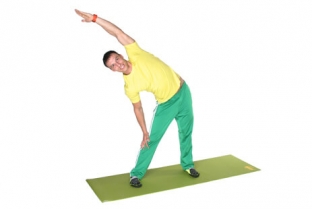
Exercise 2. – Hand circles
First, do circular swings forward with one hand, then the other. Next, perform circular swings alternately with your hands back. Swing with both arms from the shoulder with maximum amplitude.
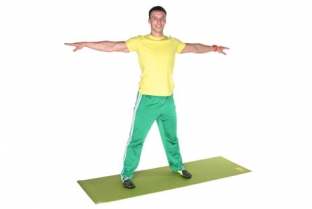
Exercise 3. – Stretching up and to the sides
Close your fingers into the castle and lift above your head. Stretch your arms up, keeping your heels off the floor. Next, stretch to the sides, clasping your hands in the castle.
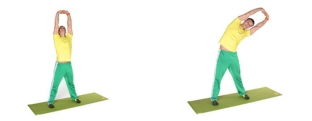
Exercise 4. – Knee Rotation
Stand straight, put your feet together and bend your knees a little. Bend over and place your hands on your knees. Rotate your knees to the right and left.
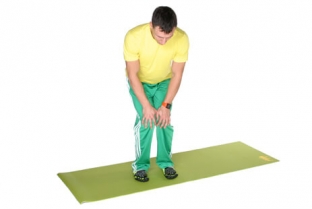
Exercise 5. – Incline Squats
Feet together, lean forward and place your palms on the floor near your feet. Do not take your hands off, squat and rise while inhaling and exhaling.
In addition, the pre-workout warm-up may include: running in place, jumping rope, Burpee exercise.
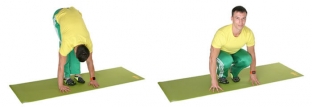
Cool down after workout – effective end of class
Do not forget that you should finish an active workout with relaxing exercises aimed at restoring breathing, body temperature, and pulse rate.
If you suddenly stop loading the muscles, the lactic acid accumulated during the active work of the muscular apparatus will begin to poison the fibers and there will be no benefit from training. The cool down is necessary to remove lactic acid from the muscles, to reduce blood flow to the muscles.
Cool down exercises:
- Slow walking in place followed by a stop;
- Spread your arms to the sides, as you exhale, connect in front of you, tilting your head, lower your arms down, crossing them.
- Shake your arms and legs to relax your muscles.

Warming up before a workout is just as necessary as a cool down after it. Do it right, and your well-being will always please!
Read also: "Krepatura after training: how to relieve muscle pain"






Add a comment